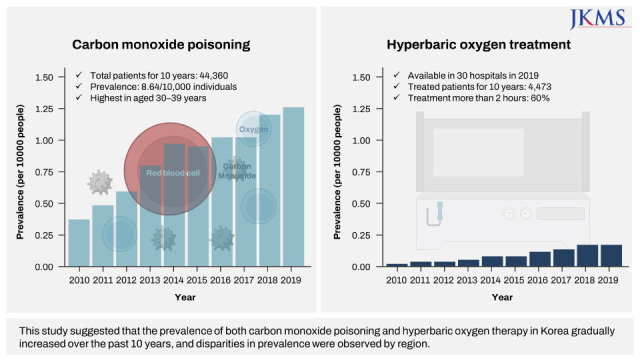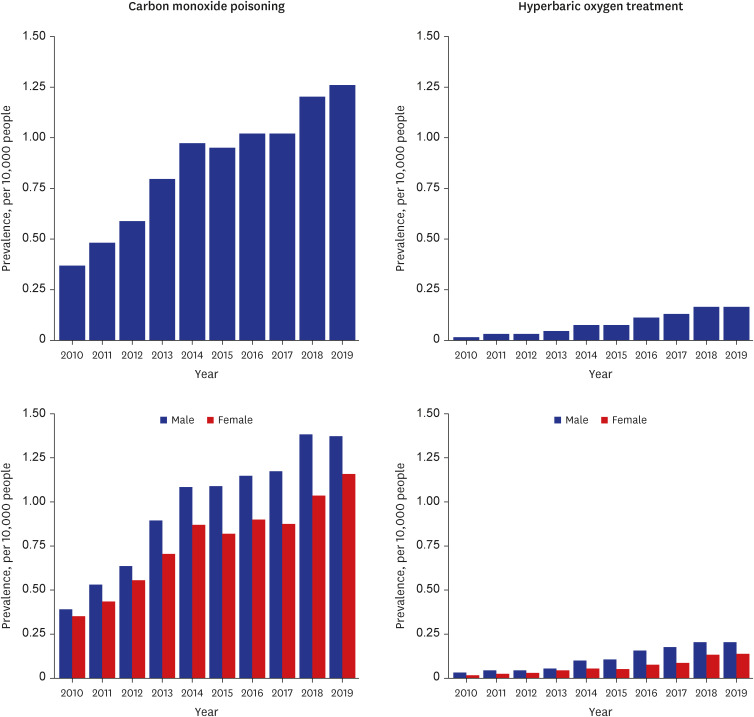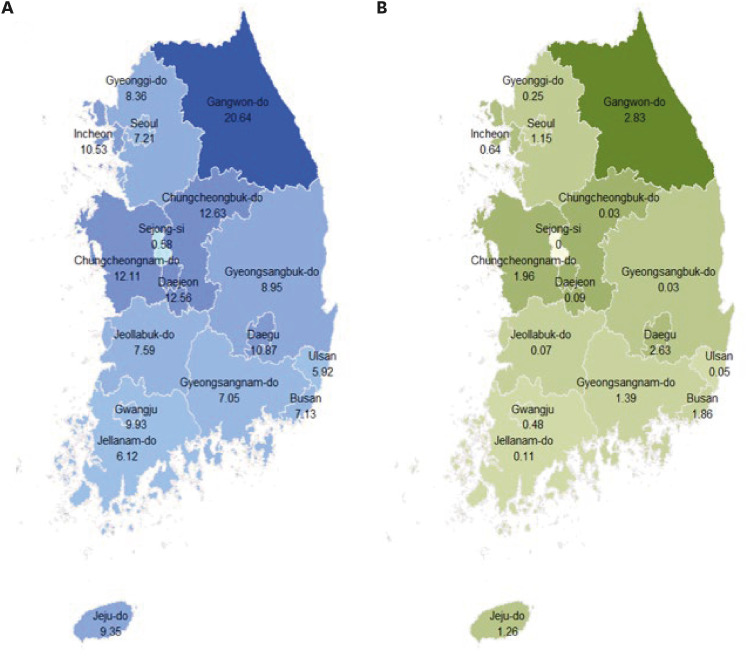Abstract
This study aimed to investigate the prevalence of carbon monoxide (CO) poisoning and the provision of hyperbaric oxygen therapy (HBOT) in South Korea. We used data from the Korea Health Insurance Review and Assessment service. In total, 44,361 patients with CO poisoning were identified across 10 years (2010–2019). The prevalence of CO poisoning was found to be 8.64/10,000 people, with a gradual annual increment. The highest prevalence was 11.01/10,000 individuals, among those aged 30–39 years. In 2010, HBOT was claimed from 15 hospitals, and increased to 30 hospitals in 2019. A total of 4,473 patients received HBOT in 10 years and 2,684 (60%) were treated for more than 2 hours. This study suggested that the prevalence of both CO poisoning and HBOT in Korea gradually increased over the past 10 years, and disparities in prevalence were observed by region.
Graphical Abstract

Carbon monoxide (CO) poisoning was common in Korea in the past because coal briquettes were often used for heating in households. Since the 1990s, CO poisoning has decreased as other fuel sources have replaced coal briquettes.1 According to the Korean Statistical Information Service, the proportion of briquette boilers in Korean household heating systems decreased from 13.2% in 1995 to 4.1% in 2019.2 However, as more people have chosen camping as a recreational activity in recent years, the number of patients visits to emergency department (ED) for CO poisoning by reckless usage of camping supplies, like fuel or heating appliances, has also increased.3 Moreover, CO poisoning has emerged as an significant suicide method in Korea after the suicidal death of a famous actress in 2008, increasing 30-fold between 2006 and 2012.4
CO binds to hemoglobin to form carboxyhemoglobin, which produces various systemic and neurological complications from tissue hypoxia.56 The majority of patients with CO poisoning are classified as mild to moderate in severity; however, severe symptoms such as convulsion and cerebral infarction may also occur, leading to death. Hyperbaric oxygen therapy (HBOT) has been used as a treatment method for CO poisoning to minimize these complications.78 In Korea, as the number of hospitals with hyperbaric oxygen chambers is gradually increasing, HBOT is administered to patients with CO poisoning more frequently, as well as for various other indications.9
There have been several studies on CO poisoning in Korea,1011 but few on the prevalence of CO poisoning and status of HBOT provision based on nationwide data. We investigated the prevalence of CO poisoning and the provision of HBOT from 2010 to 2019, based on the National Health Insurance claims data.
This study analyzed patients who attended hospitals for CO poisoning over 10 years (2010–2019), based on the total population data of approximately 50 million people, along with claims data from the Health Insurance Review and Assessment Service (HIRA). Korea has adopted a single health insurance system led by the government, consisting of the National Health Insurance (approximately 97% of the population) and medical benefits (for the remaining 3%; low-income class).12
The HIRA is an independent Korean government agency that evaluates medical claims data from all medical institutions in Korea. Using this claims data, the authors collected demographic and medical information regarding diagnosis, procedure, and prescription. Because the HIRA data is transmitted anonymously, researchers are not aware of potentially identifiable personal information.
The 7th edition of the Korean Classification of Diseases, which revised the 10th edition of the International Classification of Diseases to match the Korean healthcare system, is used when Korean medical insurance claims are submitted to the HIRA. The database was searched from 2010 to 2019 to retrieve records of patients with codes related to CO poisoning (T58, X47*, X67*, X88*, and Y17*) and HBOT (M058* and M586*). The prevalence rate, according to the age and gender of patients and the province and the number of hospitals providing HBOT, was investigated annually. Population numbers were collected from the national statistics portal by region, year, age, and sex.2
The prevalence of CO poisoning and the provision of HBOT were calculated as the number of cases per 10,000 people. The annual prevalence was calculated as the point prevalence, and the overall prevalence by age, gender, and region was calculated as the period prevalence. Treatment time of HBOT is classified based on the treatment codes: for example, up to 1 hour (M0581, 0586); over 1 hour, up to 2 hours (M0582, 0587); and over 2 hours (M0583, 0588). The M586* code was used until June 2017; since then, the M058* code has been used for HBOT. The duration of HBOT was calculated as the total treatment time over 1 year. Data were analyzed using the SAS software (version 9.4; SAS Inc., Cary, NC, USA).
The prevalence of CO poisoning was 8.64 per 10,000 people (9.62 for men and 7.66 for women). The highest prevalence was 11.01 in those aged 30–39 years (13.43 for men and 8.48 for women, Supplementary Table 1). The prevalence by year was 0.37 in 2010 and 1.26 in 2019, showing a gradual increase (Fig. 1). By region, the Gangwon province had the highest period prevalence at 20.64, followed by Chungcheongbuk-do at 12.63 (Fig. 2A). In the previous study,10 Seoul and the Gyeonggi province were found to have the highest number of patients with CO poisoning. However, since these metropolitan areas have large populations, Gangwon had a high period prevalence per population. The reasons for the high prevalence in the Gangwon province can be partly attributed to differences in heating methods and increased outdoor activities, such as camping. Regarding the heating method by region in 2019, the proportion of coal briquette boilers was 3.6% in Gyeonggi, compared with 6.2% in the Gangwon province.2
A total of 4,473 patients (10.1% of CO poisoning) received HBOT over 10 years. The frequency was the highest among individuals aged 30–39 years. Overall, men (63.5%) received more HBOT than women. Comparing the provision of HBOT per population by region, Gangwon and Daegu showed the highest rates (Fig. 2B). In 2019, there were two multiplace and four monoplace HBOT chambers in the Gangwon province, which was the second most widely equipped following Jeju province. In 2010, 15 hospitals claimed the HBOT for patients with CO poisoning; however, the number of hospitals gradually increased to 19 in 2017 and 30 in 2019. In this study, patients who received HBOT only for CO poisoning were included. However, 14,995 patients received HBOT from various indications in 2019, and the number of institutions capable of HBOT at more than 2 atm increased to 50 in 2021.9
The prevalence of CO poisoning was found to be increasing in this study. The CO poisoning has gradually been decreasing in developed countries such as the United States and the United Kingdom,1314 while it still be a public health problem in countries that uncontrolled heating systems like coal stoves and hot water heaters are mainly used.15 The cause of CO poisoning can be classified by intentionality. In Korea, intentional cause has been reported in 35–44% of CO poisoning.1011 A study using the nationwide ED data from 2014 to 2018 reported that 35% of patients with CO poisoning visited to EDs were due to intentional poisoning.10 Another study from 20 EDs from 2011 to 2014 reported that intentional cause accounted for 44% of all CO poisoning cases.11 Suicidal death by CO poisoning started to increase from 0.5/100,000 people in 2008 to 3.2 in 2013 and 3.9 in 2019. As a result, gas poisoning has become the third highest method of suicide since 2013, following hanging and falling. Suicide by CO poisoning is more common in men (80.3%), especially those aged 25–44 years.16 The age-standardized suicide rate (per 100,000 people) for CO poisoning by region were equally highest in Gangwon, Daejeon, and Ulsan (4.8/100,000).17 To prevent suicide by CO poisoning, it is recommended that the quality of burning charcoal should be improved to weaken the toxicity and that mass media guidelines for reporting suicide events of influential people should be followed.18 The charcoal restriction program has shown no effect on suicide reduction by charcoal-burning or overall suicides.19
Since unintentional CO poisoning tends to increase in winter,11 it is estimated that the most common cases are caused by incomplete combustion of heating appliances. In December 2018, high school students were poisoned by CO due to a poorly constructed gas boiler at a pension house in Gangwon province, drawing significant social attention. Mandating CO detectors in residence areas has been found to be cost effective.2021 The odds of CO poisoning were 3.2 times higher (95% confidence interval, 1.5–6.9) among those who had no CO detector than had detector with an alarm.22 In Korea, it has become mandatory to install CO detectors in lodging facilities since August 2020.
This study has some limitations. First, the HIRA data only provided the disease codes and demographic information. Thus, there were no data available on the details of cause of poisoning, intentionality, and clinical progress. Second, the number of patients may have been overestimated when patients were transferred for reasons such as the absence of HBOT equipment. Further studies on the exact causes and factors affecting the prevalence of CO poisoning are required.
This study suggests that there is an increased trend in the prevalence of patients with CO poisoning in Korea, and that the number of patients who received HBOT and hospitals capable of HBOT has also increased. We also found differences in the prevalence of CO poisoning and HBOT provision per population according to the region, and interventions to mitigate these disparities should be conducted in the future.
ACKNOWLEDGEMENTS
This study used research data of the Health Insurance Review and Assessment Service (M20210304140).
References
1. Kim JH, Lim AY, Cheong HK. Trends of accidental carbon monoxide poisoning in Korea, 1951-2018. Epidemiol Health. 2020; 42:e2020062. PMID: 32882118.
2. Statistics Korea. Korean Statistical Information Service homepage. Updated 2023. Accessed January 18, 2023.
https://kosis.kr
.
3. Kim YJ, Sohn CH, Oh BJ, Lim KS, Kim WY. Carbon monoxide poisoning during camping in Korea. Inhal Toxicol. 2016; 28(14):719–723. PMID: 27919173.
4. Choi YR, Cha ES, Chang SS, Khang YH, Lee WJ. Suicide from carbon monoxide poisoning in South Korea: 2006-2012. J Affect Disord. 2014; 167:322–325. PMID: 25016488.
5. Choi IS. Carbon monoxide poisoning: systemic manifestations and complications. J Korean Med Sci. 2001; 16(3):253–261. PMID: 11410684.
6. Rhee B, Kim HH, Choi S, Min YG. Incidence patterns of nervous system diseases after carbon monoxide poisoning: a retrospective longitudinal study in South Korea from 2012 to 2018. Clin Exp Emerg Med. 2021; 8(2):111–119. PMID: 34237816.
7. Weaver LK. Clinical practice. Carbon monoxide poisoning. N Engl J Med. 2009; 360(12):1217–1225. PMID: 19297574.
8. Huang CC, Ho CH, Chen YC, Lin HJ, Hsu CC, Wang JJ, et al. Hyperbaric oxygen therapy is associated with lower short- and long-term mortality in patients with carbon monoxide poisoning. Chest. 2017; 152(5):943–953. PMID: 28427969.
9. Lee SM, Heo T, Kim G, Kim H. Current status and development direction of hyperbaric medicine in Korea. J Korean Med Assoc. 2022; 65(4):232–238.
10. Lee S, Lee J, Kim KH, Park J, Shin DW, Kim H, et al. Trends of carbon monoxide poisoning patients in emergency department: NEDIS (National Emergency Department Information System). J Korean Soc Emerg Med. 2021; 32(1):27–35.
11. Bae S, Lee J, Kim K, Park J, Shin D, Kim H, et al. Epidemiologic characteristics of carbon monoxide poisoning: emergency department based injury in-depth surveillance of twenty hospitals. J Korean Soc Clin Toxicol. 2016; 14(2):122–128.
12. National Health Insurance Service. National Health Insurance population distribution. Updated 2022. Accessed January 18, 2023.
https://www.nhis.or.kr/nhis/policy/wbhada01700m01.do
.
13. Hampson NB. U.S. mortality due to carbon monoxide poisoning, 1999-2014. Accidental and intentional deaths. Ann Am Thorac Soc. 2016; 13(10):1768–1774. PMID: 27466698.
14. Roca-Barceló A, Crabbe H, Ghosh R, Freni-Sterrantino A, Fletcher T, Leonardi G, et al. Temporal trends and demographic risk factors for hospital admissions due to carbon monoxide poisoning in England. Prev Med. 2020; 136:106104. PMID: 32353574.
15. Unsal Sac R, Taşar MA, Bostancı İ, Şimşek Y, Bilge Dallar Y. Characteristics of children with acute carbon monoxide poisoning in Ankara: a single centre experience. J Korean Med Sci. 2015; 30(12):1836–1840. PMID: 26713060.
16. Jo H, Lee K, Son S, Kang H, Kim S, Roh S. Clinical characteristics of people who attempted suicide by carbon monoxide poisoning in Korea. Mood Emot. 2020; 18(3):100–109.
17. Ministry of Health and Welfare (KR). Korea Foundation for Suicide Prevention. White Paper on Suicide Prevention 2022. Seoul: Korea Foundation for Suicide Prevention;2022.
18. Lee T, Lee AR, Ahn MH, Jeong SY, Hong JP. Overview of suicide by charcoal burning and prevention strategies. J Korean Neuropsychiatr Assoc. 2014; 53(1):1–7.
19. Chang SS, Lin CY, Hsu CY, Chen YY, Yip PS. Assessing the effect of restricting access to barbecue charcoal for suicide prevention in New Taipei City, Taiwan: a controlled interrupted time series analysis. J Affect Disord. 2021; 282:795–802. PMID: 33601720.
20. Ran T, Nurmagambetov T, Sircar K. Economic implications of unintentional carbon monoxide poisoning in the United States and the cost and benefit of CO detectors. Am J Emerg Med. 2018; 36(3):414–419. PMID: 28888530.
21. Hampson NB. Cost effectiveness of residential carbon monoxide alarms. Undersea Hyperb Med. 2017; 44(5):393–397. PMID: 29116693.
22. Christensen GM, Creswell PD, Theobald J, Meiman JG. Carbon monoxide detector effectiveness in reducing poisoning, Wisconsin 2014-2016. Clin Toxicol (Phila). 2020; 58(12):1335–1341. PMID: 32163299.
SUPPLEMENTARY MATERIAL
Supplementary Table 1
The Prevalence rate of CO poisoning and HBOT in Korea between 2010–2019 by age group and gender




 PDF
PDF Citation
Citation Print
Print





 XML Download
XML Download